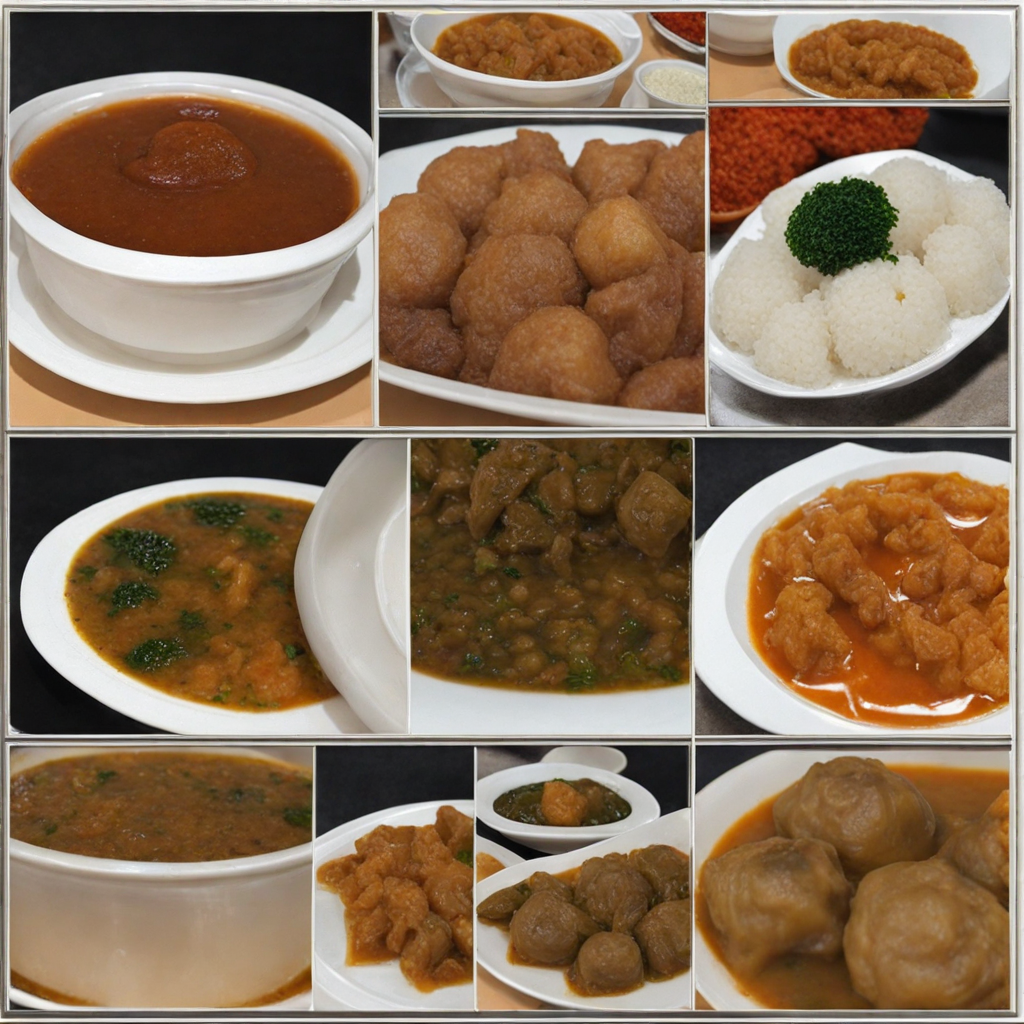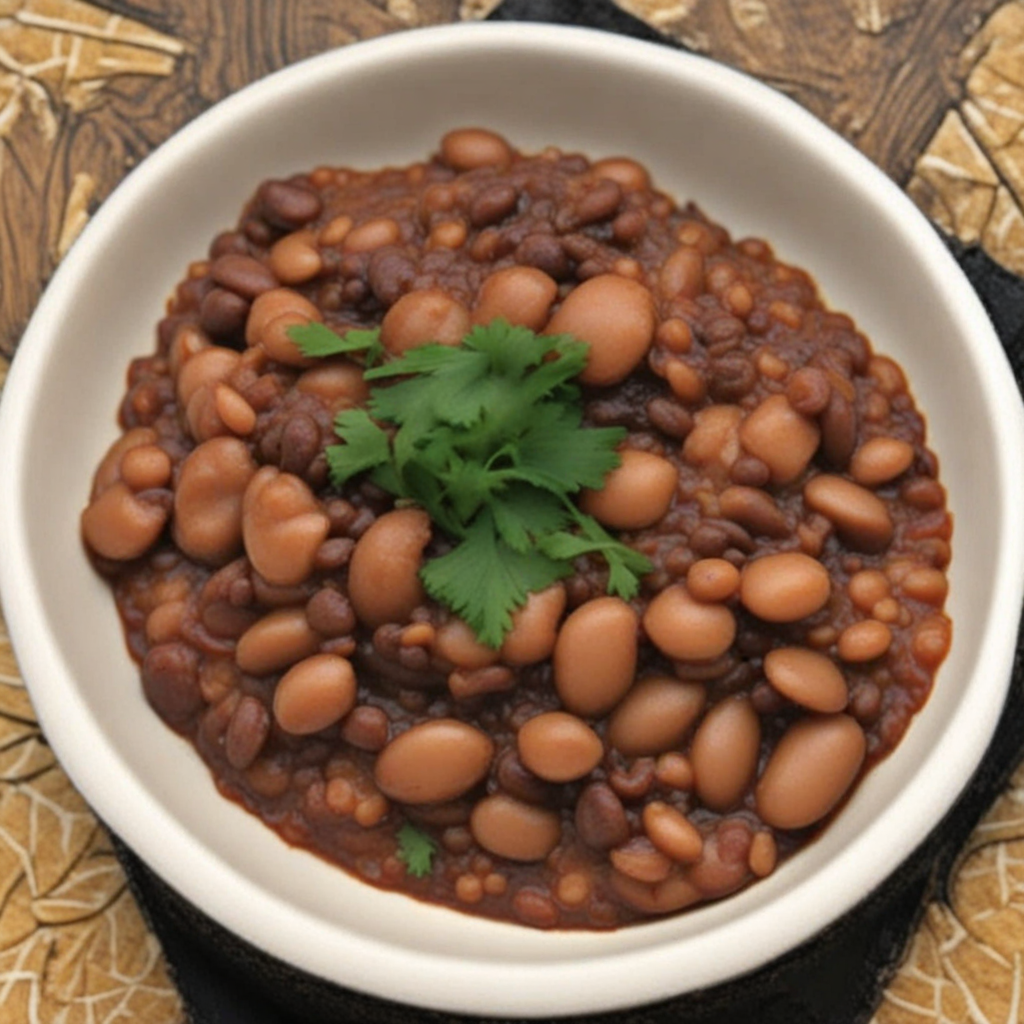Fufu
Fufu is a traditional Nigerian dish that embodies the rich culinary heritage of West Africa. It is a starchy side dish made primarily from cassava, yams, or plantains, which are boiled until soft and then pounded into a smooth, stretchy consistency. This labor-intensive process results in a fluffy, dough-like texture that serves as a perfect accompaniment to a variety of soups and stews. The subtle flavor of fufu allows it to absorb the spices and aromas of the dishes it's paired with, making it an essential staple in Nigerian cuisine. In the dining experience, fufu is typically served as a communal dish, where diners tear off pieces with their hands and use them to scoop up flavorful soups, such as egusi or ogbono. The act of eating fufu is not only about the food itself but also about the shared enjoyment and connection it fosters among family and friends. The texture of fufu is unique, offering a satisfying chewiness that contrasts beautifully with the richness of the accompanying stews, creating a delightful balance of flavors and sensations in each bite. Fufu is more than just a meal; it represents a cultural significance deeply rooted in Nigerian traditions. It is a source of comfort and nourishment, often enjoyed during festive occasions and family gatherings. As you explore the taste of fufu, you'll find it evokes a sense of warmth and community, making it a dish worth experiencing for anyone eager to dive into the vibrant world of Nigerian cuisine.
How It Became This Dish
The History of Fufu: A Culinary Staple of Nigeria Fufu is more than just a food item; it is a cultural symbol deeply rooted in the history and traditions of Nigeria and several other West African countries. Its journey through time reflects the resilience of local communities, the evolution of agricultural practices, and the rich tapestry of Nigerian identity. #### Origins and Early History The origins of fufu can be traced back centuries, with some historians estimating its beginnings as far back as 2000 BC. While the exact time and place of its inception remain somewhat elusive, it is widely believed that fufu emerged in regions of West Africa where cassava, yams, and plantains were cultivated. These starchy tubers and fruits were not only abundant but also staple foods for many indigenous communities. The word "fufu" is derived from the Akan language of the Ghanaian people, where it means "mash" or "to mash." This etymology points to the method of preparation, which involves boiling and then pounding the starchy base until it reaches a smooth, elastic consistency. The pounding process, traditionally carried out using a mortar and pestle, is labor-intensive and often seen as a communal activity, wherein family members gather to partake in the preparation, fostering social bonds and shared traditions. #### Cultural Significance Fufu holds a prominent place in Nigerian culinary practices and is considered a staple food across various ethnic groups, especially the Yoruba, Igbo, and Efik. Each group has its unique variations of fufu, often based on the local crops available to them. For instance, the Yoruba are known for their yam fufu, while the Igbos traditionally favor cassava fufu, called "fufu" or "akpu." Fufu’s cultural significance extends beyond its nutritional value. It is often served as an accompaniment to soups and stews, such as egusi (melon seed soup) and ogbono (wild mango seed soup), and is integral to communal dining experiences. Eating fufu is typically a hands-on affair; diners mold a ball of fufu with their fingers and then dip it into the accompanying soup. This practice embodies the communal spirit of Nigerian culture, emphasizing togetherness and shared experiences. Moreover, fufu is often featured in ceremonies and celebrations, such as weddings and festivals, where its preparation and consumption symbolize unity and abundance. In religious contexts, fufu can also be offered as a part of sacrifices to ancestors or deities, highlighting its spiritual significance in many Nigerian traditions. #### Development Over Time As Nigeria's population grew and its cultural landscape diversified, so did the preparation and consumption of fufu. The introduction of new cooking techniques and ingredients, influenced by trade routes and colonial encounters, brought about variations in fufu's preparation. The Portuguese, for example, introduced new cassava varieties, which would eventually lead to the popularization of cassava fufu in the southern regions of Nigeria. The advent of globalization has also impacted the way fufu is perceived and consumed. In urban areas, where convenience often takes precedence, pre-packaged fufu products have emerged, allowing consumers to prepare fufu with relative ease. These instant fufu options are becoming increasingly popular among the younger generation who may not have the time or resources to engage in traditional preparation methods. Despite these modern adaptations, traditional methods of preparing fufu remain prevalent, especially in rural communities where cultural heritage is cherished and preserved. The labor-intensive process of pounding fufu serves as a rite of passage for many young people, often taught by elders who impart not just culinary skills but also cultural values and stories associated with the dish. #### Regional Variations While the basic concept of fufu remains consistent, regional variations have emerged, each with its distinct flavor and texture. In the Southern Nigerian regions, where cassava is widely cultivated, "akpu" (cassava fufu) is favored for its slightly sour taste, a result of fermentation during the preparation process. In contrast, the Northern regions often utilize grains such as millet or sorghum to create a different texture and flavor profile. In addition to these traditional forms, fufu has transcended its regional boundaries and has been embraced by diasporic communities around the world. As Nigerians migrated to different parts of the globe, they carried their culinary traditions with them, introducing fufu to new audiences. In cities like London, New York, and Toronto, fufu can now be found in various African and Caribbean restaurants, often paired with diverse stews that reflect the culinary innovations of immigrant chefs. #### Fufu in Contemporary Society Today, fufu is emblematic of the resilience and adaptability of Nigerian culture. It serves as a reminder of the importance of food in shaping identity and community. As Nigeria grapples with rapid urbanization, globalization, and changing lifestyles, the role of fufu continues to evolve. Younger generations are increasingly finding ways to incorporate traditional dishes into their modern lives, whether through social media platforms or fusion cuisine. Moreover, there is a growing movement within Nigeria to celebrate and promote traditional foods, including fufu, as a way to combat the influence of fast food and processed diets. Nutritionists and chefs alike are emphasizing the health benefits of staple foods like fufu, which are rich in carbohydrates and provide essential energy for daily activities. #### Conclusion Fufu is more than just a food; it is a cultural artifact that tells the story of Nigeria’s rich agricultural heritage, communal traditions, and evolving identity. As it continues to adapt to the changing social landscape, fufu remains a beloved staple that nourishes not only the body but also the spirit of togetherness. In every ball of fufu shared among family and friends lies a history of resilience, community, and cultural pride, ensuring that this timeless dish will endure for generations to come.
You may like
Discover local flavors from Nigeria







